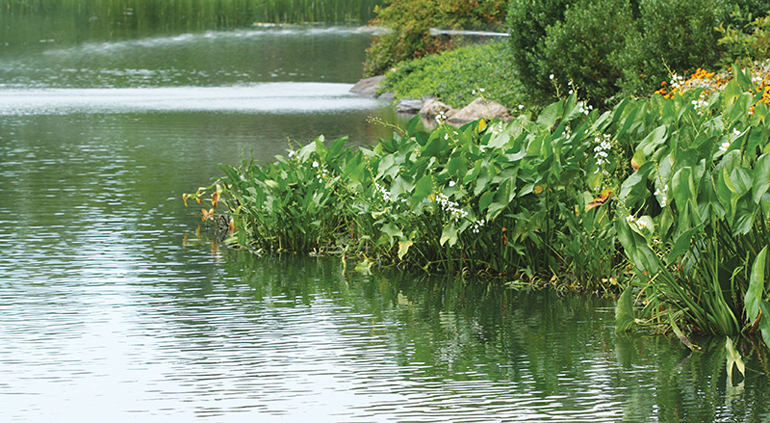
What is there not to love about Sagittaria latifolia? For starters, there’s its beauty. Sagittaria is known for its verdant green, sagittate (or arrowlike) leaves coming off a central stem that is held aloft over shallow waters. White-petaled flowers bloom from June to mid-August. These plants are often at their best in the withering heat of August. Sagittaria is a strong grower and can spread vigorously. Like a friendly bully, it offers habitat and cover to wildlife while protecting against invasive, sun-loving water pests — animal and plant alike. The plants also offer a food source for waterfowl, which reminds me of the saying, “Duck potatoes are crackers for quackers!” More on that in a minute.
The Sagittaria has long been favored as an attractive water garden plant and is shown to its best advantage when mixed with Pontederia cordata and other wetland species, including bulrushes, which provide a contrasting vertical element. This vigorous aquatic perennial is native to the continental United States and Puerto Rico. Sagittaria is famed for its distinctively arrow-shaped leaves and takes its botanical name from the astrological sign Sagittarius —“ the archer. The plants vary in height and can grow to between 2 and 4 feet tall. They emerge from rhizomes with single, white flowers and form on the central stalk from the base of the plant. Sagittaria commonly grow submerged in shallow water or out of water on wet, muddy banks, sloughs, swamps, marshes and the margins of streams and ponds.
Native Varieties

The two most common varieties in the United States are Saggitaria latifolia and Sagittaria rigida.
Sagittaria latifolia, commonly known as duck potato, is a vigorous aquatic perennial that typically grows 2 to 4 feet tall. The plant features strongly peaked, arrowhead-shaped leaves. Green Sagittaria latifolia commonly grows submerged in shallow waters. It is easy to naturalize and will colonize by spreading rhizomes and through self-seeding (Zones 3-11).
Sagittaria rigida, also known as the Grass Leaf Arrowhead, is found in swamps, bogs, marshes and shallow waters in both mud and sandy soils. The leaves appear almost lancelike —“ long and thin, jutting out of the shallows up to 24 inches. Foliage grows to 2 feet tall above the water line in the sun to partial shade with small white flowers in midsummer. Sagittaria rigida is a strong naturalizer (Zones 3-11).
Although not strictly native, we are partial to our own less common hybrid, the Sagittaria australis ‘Benni’ Silk Stockings. Silk Stockings is a selection of a native Appalachian Arrowhead (Sagittaria australis). There are many types of Arrowhead, but none like this! It was developed by Aquascapes Unlimited and chosen for its fine, green veins over bronze-red foliage. The new leaves are particularly lovely with their dark-reddish tones and light veination. For best color, avoid hot sunlight. Morning sun followed by dappled sun or very bright shade is best, especially in warmer climates. Like all Sagittaria, Silk Stockings grows best in calm, shallow water, about ½ to 2 inches deep. The dormant tubers, which form in the fall, are edible and important wildlife food, giving rise to the name duck potato. Some species were known to the Native Americans as Wapato (Zones 5-11).
Managing these plants is surprisingly simple. Spreading by rhizome, the foliage typically dies in the winter, though this is not always the case. They leave behind tubers and seed and will emerge vigorously in the spring. Control occurs either through removing the flower stem before seeding, or through harvesting the tubers.

So, back to that “crackers for quackers” comment I made earlier. Ducks may love these tubers, but humans can enjoy them, too. In the early fall, the Sagittaria produces an edible tuber, or turion. These can be prepared for spring planting —“ or could become a harvest feast! Lucky for us as growers, we at the nursery enjoy them in what we like to call Duck Potato Heffner (see previous page). Tubers can be stored for up to six months in the fridge, and what’s left uneaten can be planted in spring. Now that’s food for thought!
RECIPE:
Duck Potato Heffner
> Duck potato tuber (soaked and peeled, about 1 pound)
> Thick-cut bacon (three slices or to taste)
> ½ tablespoon fresh garlic minced
> Salt and pepper to taste
> 1 tablespoon olive oil or butter
Cook bacon over medium heat until crisp. Remove from heat and set aside. Drain excess fat. Wash and remove stalks from the Saggittaria latifolia tuber. Peel using a peeler to remove the outer skin of the chestnut-sized duck potatoes. Add the tubers to a hot pan used for bacon along with olive oil or butter. Sautee over medium heat for about 15 minutes until tender and golden brown. Add garlic and sautee. Chop cooled bacon into bite-sized portions, add to sauteed tubers in the pan and season to taste. Transfer to serving dish. Total preparation time: about 25 minutes.


